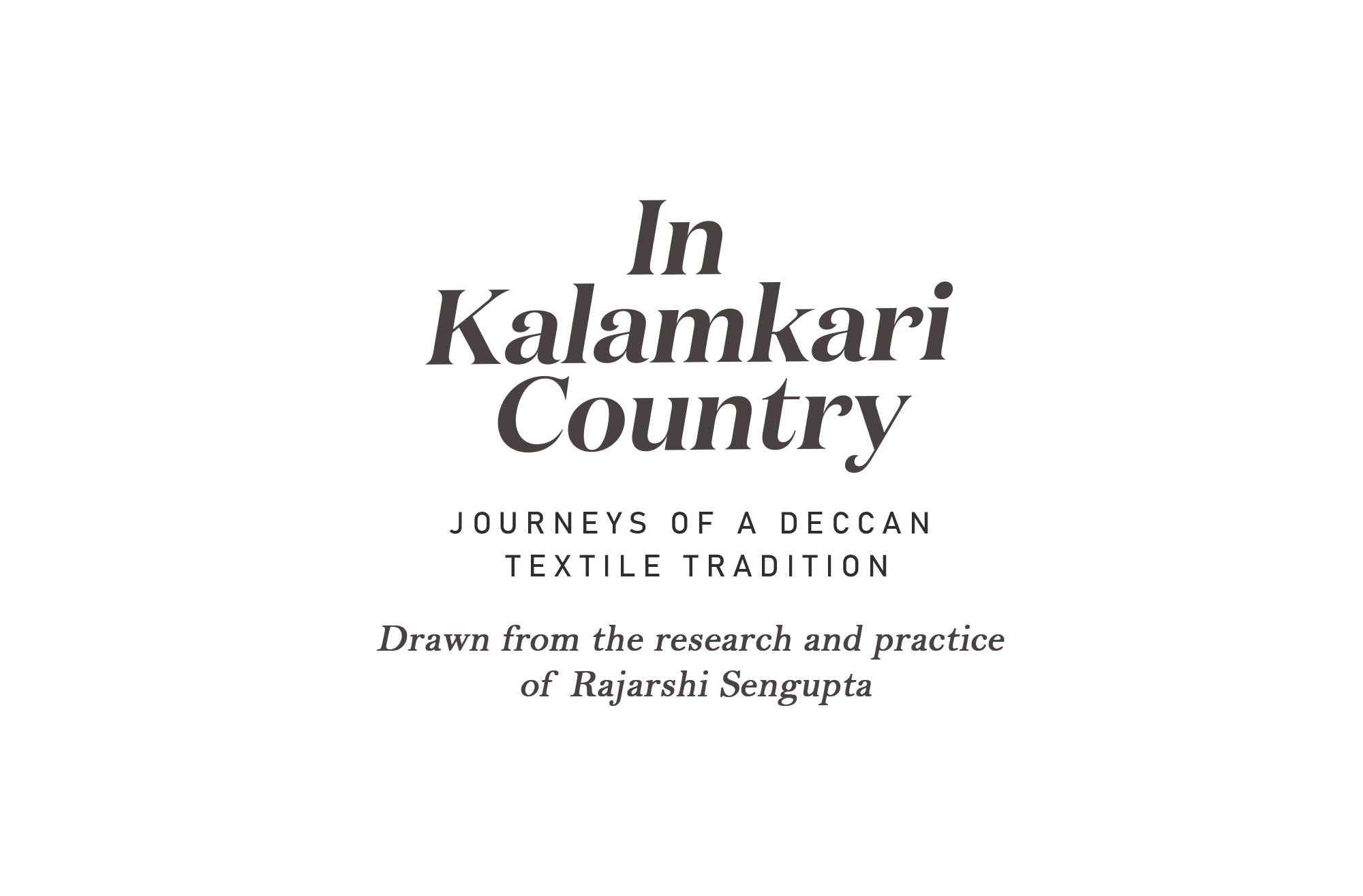


Very few physical traces remain today indicating the great former trading importance of the southeastern coast of India, previously known as the Coromandel Coast. Its once-bustling ports and busy textile centres, famous the world over for colourful printed and painted cottons, are now largely quiet. Celebrated textile centres such as Palakollu, Pulicat, and Nagapattinam ceased production in the nineteenth century. Yet connections with this proud past are visible if one knows where to look.

In Machilipatnam, that great historic cosmopolitan port town, central neighbourhoods retain the name of former trading communities, such as “Englishtown” (Englishpeta) and “Desaitown” (Desaipeta), the latter perhaps referencing settlers from Gujarat or Maharashtra. A short drive to the south, past the throngs of concrete shops and scooters, takes one to the old Dutch fort and cemetery, while a short drive north brings one to the hamlets of Pedana and Polavaram, where artisans are busy carving wooden printing blocks and weaving and printing cotton. They are not alone.
In the temple town of Srikalahasti, some four hundred fifty kilometres to the southwest, and in the great city of Hyderabad four hundred kilometres to the northwest, textile artisans have continued, through all the great ups and downs of recent centuries, to carry forward the torch of past practices—including natural dyes and hand drawing with the bamboo kalam pen.
This virtual exhibition is based on Rajarshi Sengupta’s talk for Sarmaya on Kalamkari through the Senses. Sengupta is a practitioner and art historian, who teaches fine arts at the Department of Humanities and Social Sciences at IIT Kanpur. The text for this exhibition is drawn from papers and articles authored by him, scroll to the bottom for a full bibliography.
Image: Sketch of kalamkari centres on the Coromandel Coast by Rajarshi Sengupta
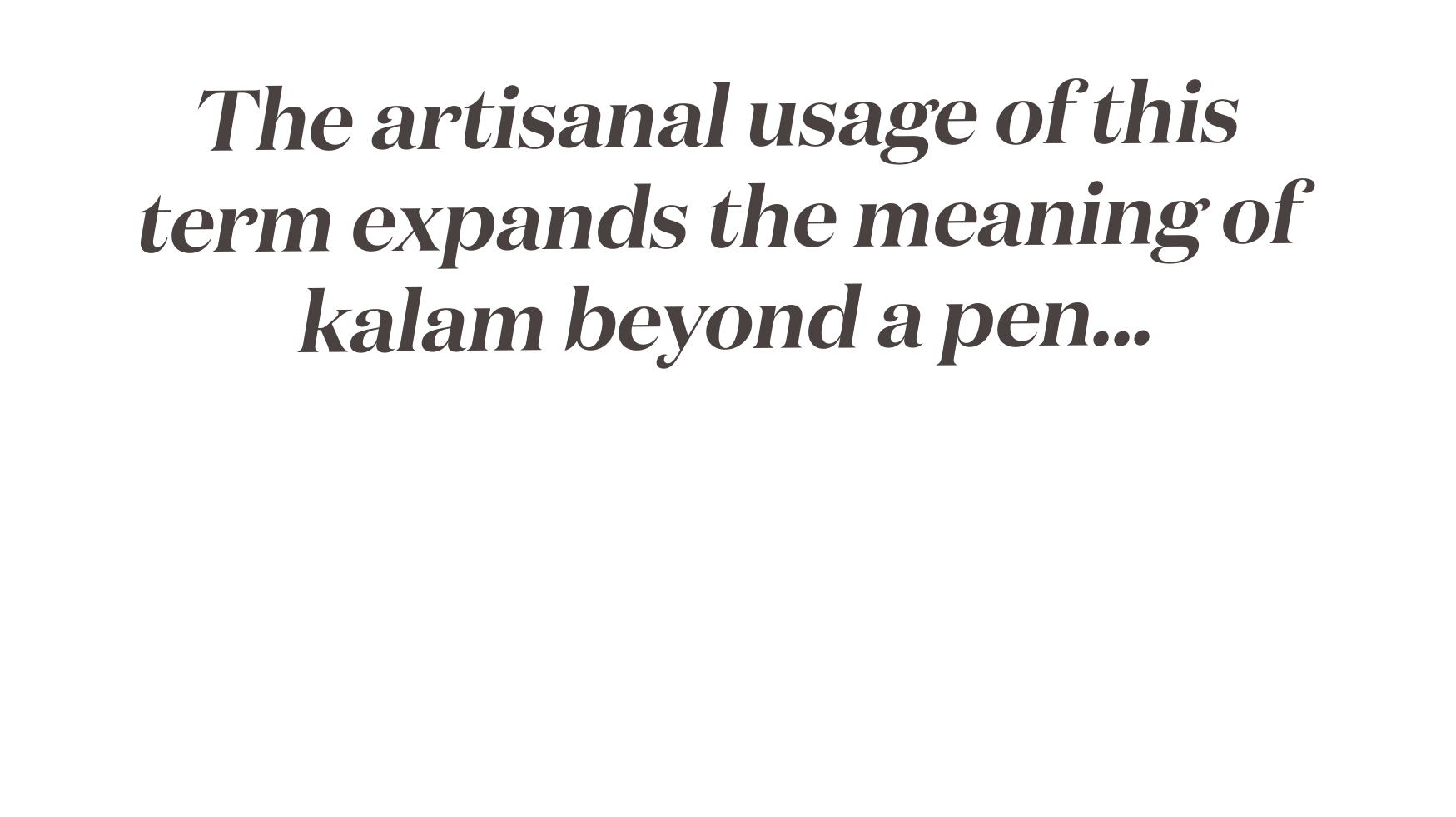
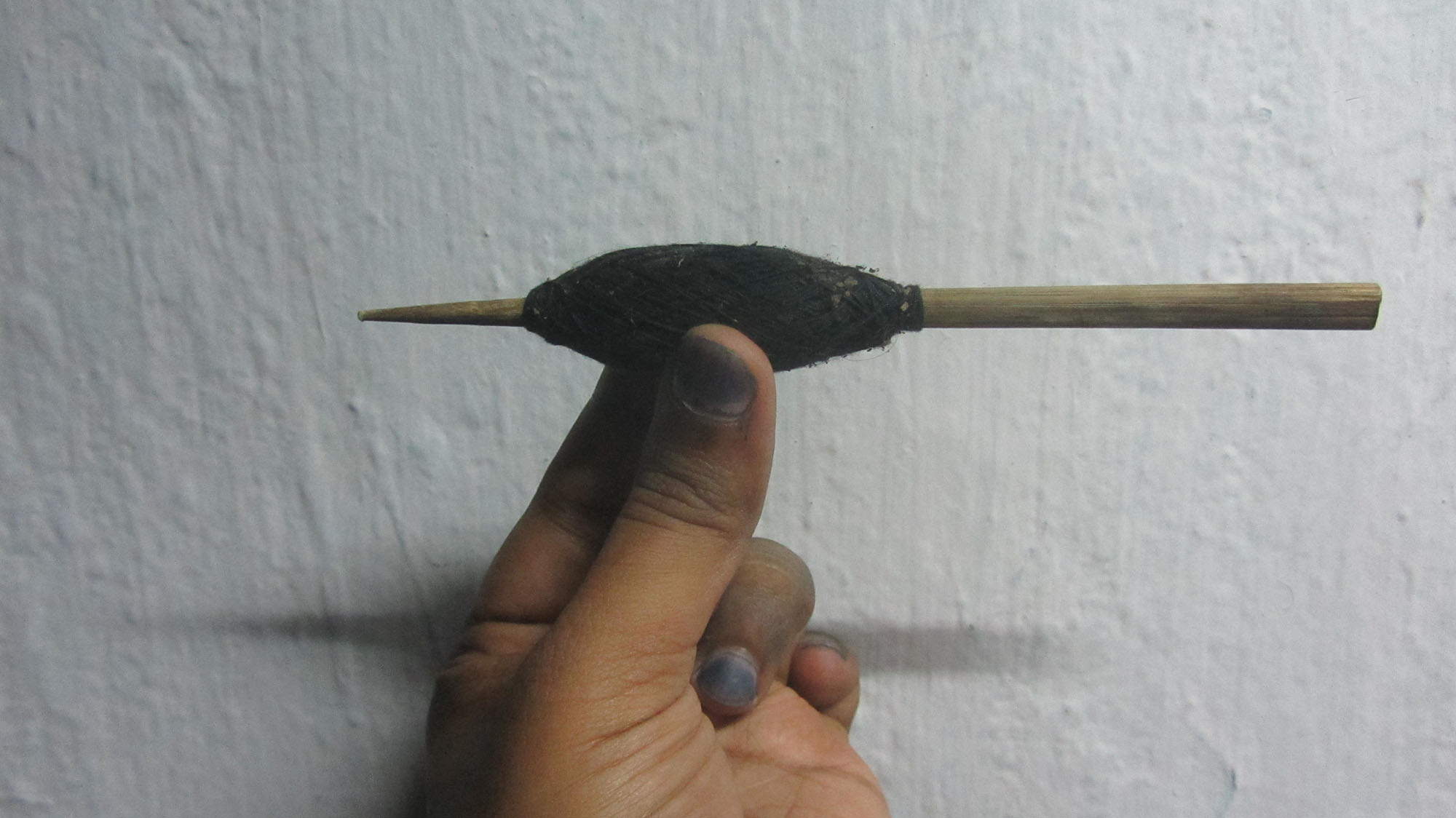
The dyed, painted, and printed cotton of the Coromandel Coast from South East India are popularly known as kalamkari, kalam meaning a pen and kari indicating to handwork.
The waqai or news reports of the Golconda court from the 1670s mention this term, which is perhaps one of the early archival records of the usage of kalamkari in Deccan. A bamboo pen with a thick grip made of cotton and cotton threads is used for making the painted textiles.
During my fieldwork, I found wooden block makers in the Bandar region of Andhra Pradesh, on the Coromandel Coast, use the term kalam to specify the iron engraving tools for block carving. The artisanal usage of this term expands the meaning of kalam beyond a pen and suggests how artisanal understanding of the histories of practice can offer fresh perspectives on material culture histories and the interconnections between painted and printed textile making. Furthermore, the term is also used by the Bidri metalware artisans from the Deccan region to denote the iron engraving tools for carving, which suggests that dyed textile making in the Coromandel region is also connected to other craft activities in Deccan.
My inquiry into the “Artisanal history of kalam” began in the wood-block making workshop of the master block carvers Kondra Gangadhar and Kondra Narsaiah, where the repetitive and rhythmic sounds of iron tools hitting the wood surfaces fill the air. K Gangadhar and K Narsaiah are among the most prolific block makers of the Machilipatnam region in Andhra Pradesh and in India more broadly.
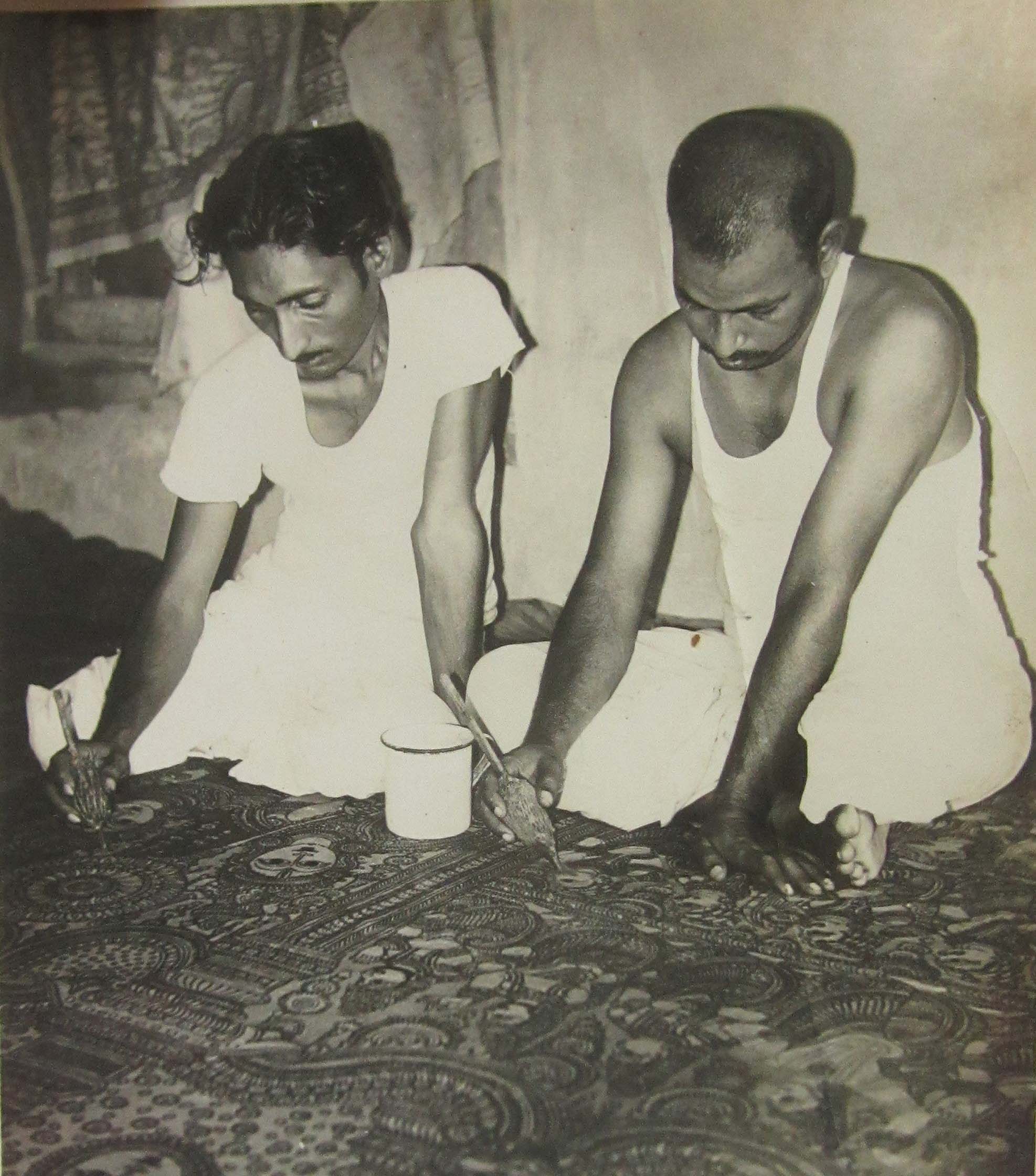
These images are executed on textiles through highly skilled handling of dyes. Contour lines defining forms and details, observed in these textiles, are often drawn with a kalam made of bamboo, cotton, and cotton threads. The wrapping of the thread, which requires a specialized skill, is done to allow maximal absorption of dye into the grip. While drawing, the practitioners gently press the grip to dispense dye into fabric.
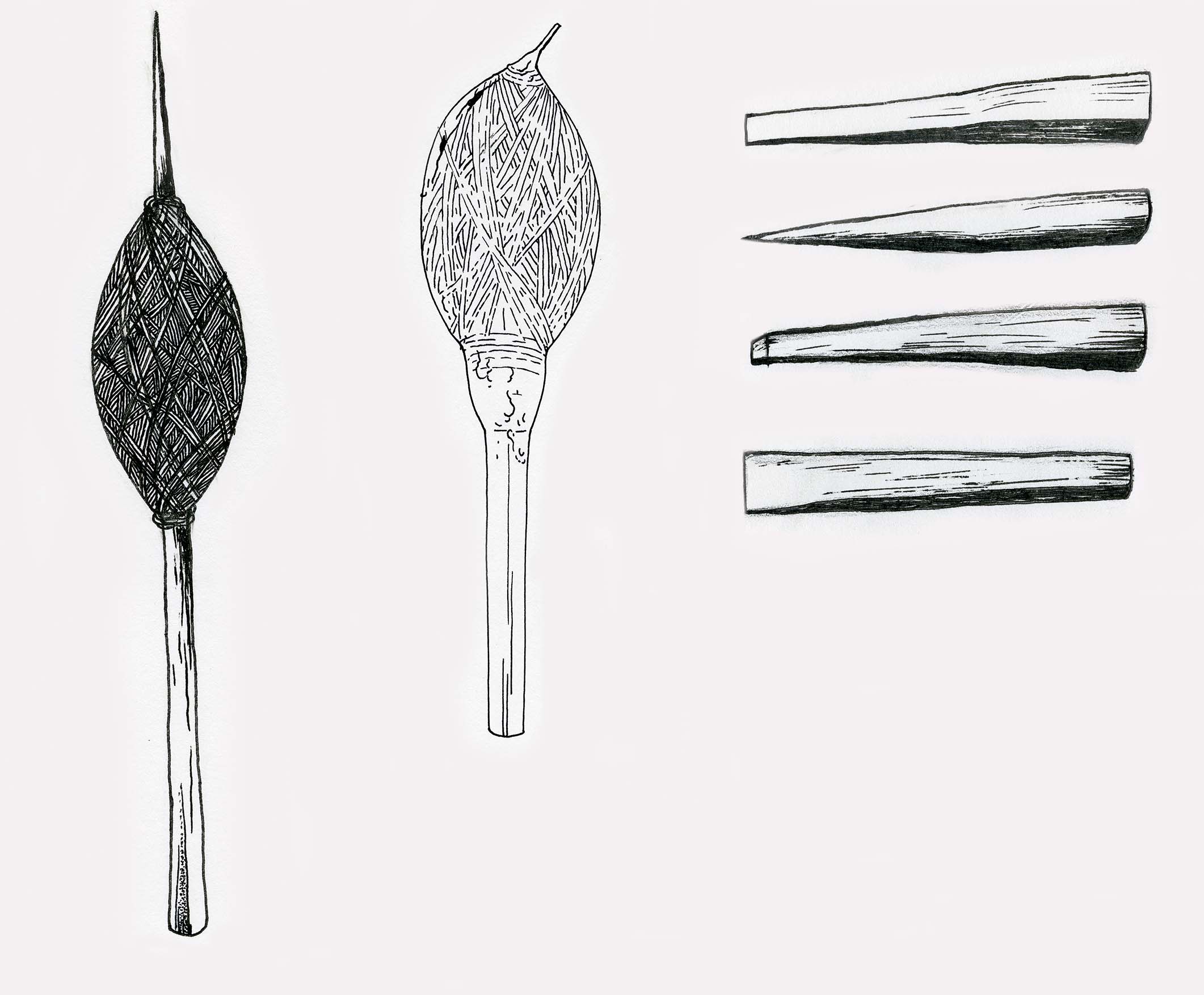
The images for block carving are first transferred to tracing papers and then traced onto the zinc oxide coated woodblock surface. Essentially two kinds of tools are used in block making: iron tools or kalam and wooden tools. Gangadhar garu and Narsaiah garu demonstrated how these tools are used. The iron tools are 3.1/2–400 in height, and they are either cylindrical or cuboid. There are no sharp edges in the upper portion of the tools so that one’s hand does not get hurt while holding them. The lower half of the tools is modeled depending on the nature of carving. For finer details, tools with a sharp needle-like tip are used, whereas for carving broad recesses, tools with varying degree of width are used.
The wooden tools are relatively simpler. Those are cuboid pieces of wood used for hammering on the iron tools to scoop out the wooden matrix. While carving, the wooden tools are held in the right hand…the iron tools are held by the nondominant hand. The images executed on the blocks range from geometrical to lyrical and of varied width.
The use of stencils and traced drawings are frequently incorporated by the present-day block makers. Using stencils as part of a composition and seamlessly merging the stencils into the visual matrix is dependent on artisanal decisions. From the sea of the reference images in their workshop, they mindfully choose the ones which serve the purpose best without disturbing the adjoining visual elements. A tendency of that is seen in the implementation of reference drawings in the hanging where the stencils and fluid line drawings co-exist.
In the workshop of the Kondra brothers, wooden blocks are prepared from the cross-sections of teak, a hardwood tree. Teak is indigenous to India but not this specific region. Wood is brought from Kothagudem (Telangana), Palasa (Andhra Pradesh), and Bastar (Chhattisgarh). The texture and durability of the wood improve with aging. Before working on the blocks, artisans check if the surface of the block is even. The unevenness of blocks affects the quality of prints. After ascertaining that the upper surface is even it is painted with zinc oxide and adhesive solution. The solution transforms the surface into a white background to execute images.
Water and waterways encircle the coastal community lives and the dyeing practices in the Coromandel region in Southern India. The dyeing practices in this region have transformed over time but the dependence on water resources for dyeing has remained.
Water and its “in-betweenness” are two pivotal components to think through the artisanal histories of the Coromandel region. Water as an element is inevitable for the production of dyes and textiles, circulation of trade goods, ideas, and knowledge between this region and the other regions of the Indian Ocean network.
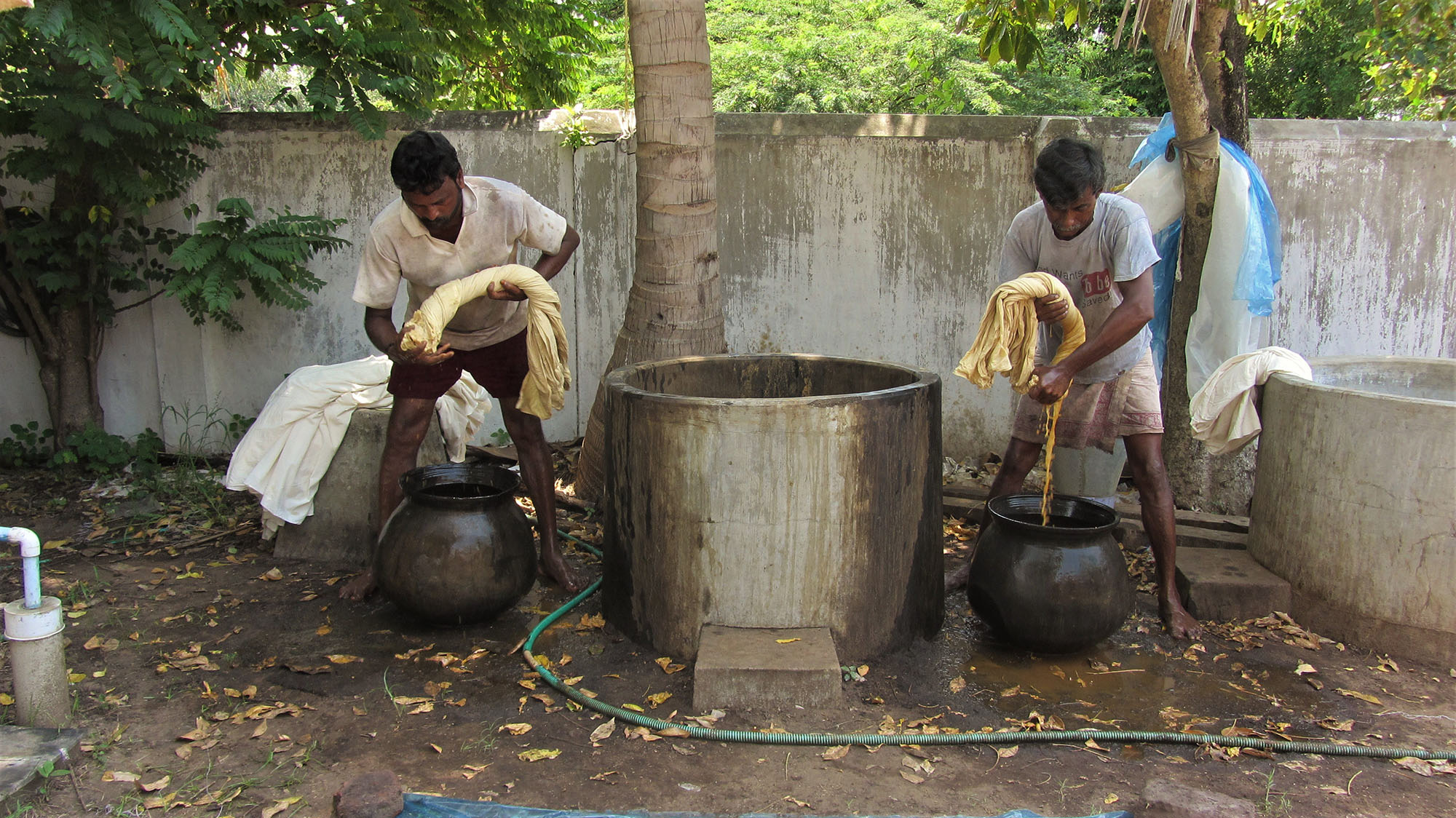
The term Coromandel possibly derived from the Tamil term Cholamandalam, evokes the rich trade history of the Chola dynasty in this region (Mukherjee 2017: 101). The long coastline is broadly divided into northern and southern Coromandel regions near the con- fluence of Krishna river in the Bay of Bengal. This riverine land and the availability of water in the region has a deep impact on the preparation and application of colors on textiles.
Organic textile dyes are all water soluble and the process of dyeing requires ready availability of water. The presence of the canals in Gulabpura and Polavaram area is a great support for local dyeing activities. Washing for dyed textiles takes place in several steps. Apart from washing the fabrics in cold water, fabrics are boiled and dried under the sun.
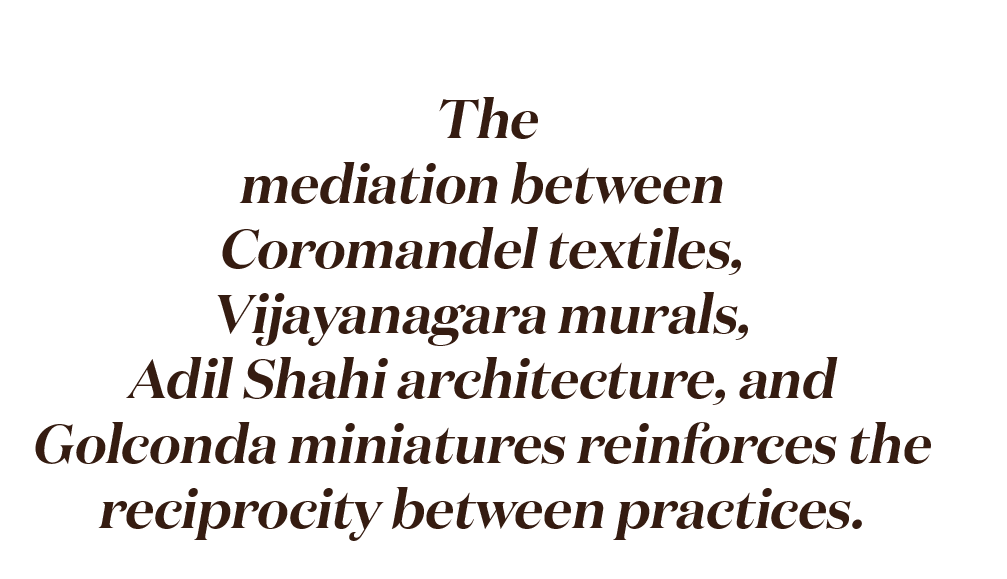
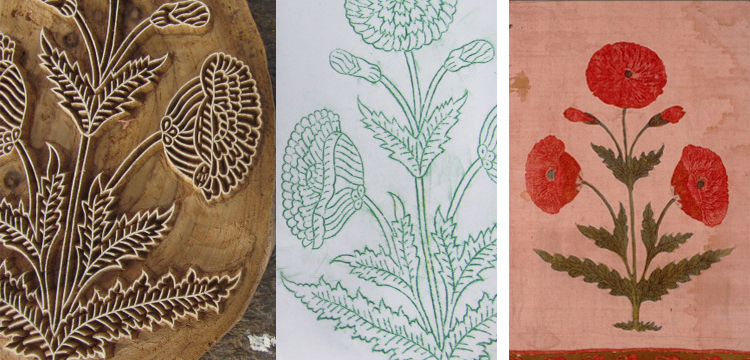
Ephemeral traced drawings are carriers of visual knowledge which are made and utilized by the block makers. In the early modern era, similar drawings were used by painters, block makers, and printers to mimic images and representing them. The mediation between tangible image sources and intangible bodily knowledge of the block makers and textile makers is represented in the visually complex and technologically sophisticated kalamkari textiles of the Coromandel region. Recognizing the mimetic interplay between intangible practices and tangible objects is a step towards recognizing artisanal subjectivity.
Several textile workshops from the Coromandel and Deccan regions came into prominence in the 16th century and carried out highly ambitious projects, including the production of floor spreads, tent hangings, prayer mats, and furnishings. Intended for both inland and overseas trade, these textiles ultimately reached a global audience and have been collected by major museums around the world. The interregional trade and intercultural exchanges generated a pool of intermediary imagery—a pivotal characteristic feature of the many early modern dyed, painted, and printed textiles.
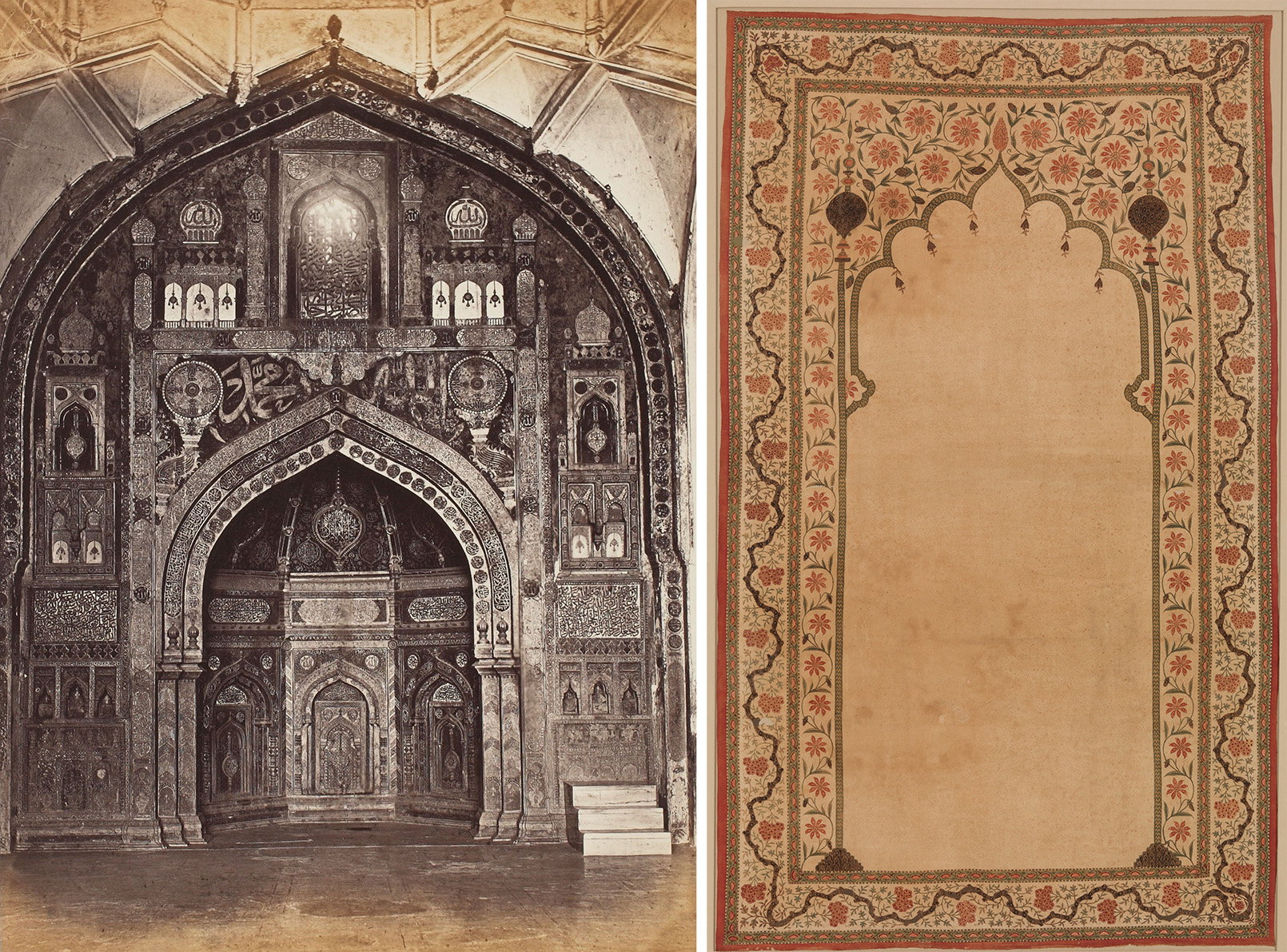
The mediation between Coromandel textiles, Vijayanagara murals, Adil Shahi architecture, and Golconda miniatures reinforces the reciprocity between practices. Whereas it has been established that the images provided by the varied groups of traders, travellers and royals served as the sources for the layered imagery on the early modern kalamkaris, the artisans were capable to respond to different criteria posed by the patrons. The kalamkari painters in the southern Coromandel region could meticulously draw the architectural features of the palace of Thirumala Nayaka of Madurai as well as the domes and arched doorways of the Golconda sultanate. The block makers and printers of the Machilipatnam area were responsible to masterfully execute cotton prayer mats and hangings for the Iranian market known as the ‘Machilipatam-type’ with pious Arabic and Iranian verses, Persian astrological signs and arched gateway. The figurative motifs on the kalamkaris which emerged out of these cross-cultural encounters belonged not only to one source but the ‘cosmopolitan Indo-Persian visual culture of the Deccan’.
For all the international admiration lavished on the Coromandel’s textiles from at least 100 CE, and still embodied in the street names of Machilipatnam, it was only homegrown movements in post-independence India that began to recognize the makers as much as their cloth. Artisans infuse their unique personalities into their works through multifaceted manoeuvres, from adapting methods to responding to geographic conditions, or retranslating contemporary visual culture in the form of comic-strip narratives.
Making dyed textiles a dynamic endeavour to bridge artisanal knowledge and artistic explorations emerges as a process situated in between immersive hands-on experimentation and sustained archival and ethnographic studies in my workspace. The transient workspace that I have maintained over the last several years has thrived alongside my transitions between interests, institutions, and lived spaces; for which, practicing dyed textiles continues as a simultaneous development of my research on the kalamkari textiles and artisanal histories of southeastern India. My training in institutional printmaking led to learning natural dyeing, painting, and printing in southern India over the last several years, which has deeply informed the thematic and methodological approach of my research. On the other hand, the study of textiles and artisanal livelihood has made me attentive to the historical and ecological significance of materials and techniques employed in my practice. The visuals in my works are part of a process of assimilating experiential narrative fragments, which repeat over time, bearing traces of multiple spaces: from the printmaking studio at the Rabindra Bharati University, Kolkata, to the kalamkari workshops in the lush green Krishna delta in Andhra Pradesh; from the collaborative studios of the Hyderabad University to the textile study centre at the Royal Ontario Museum, Toronto; from the rain-soaked winter days of Vancouver to the walled city within IIT Kanpur. Conjointly, making dyed textiles recognizes coexistence as a lingering theme that ties together questions of visuality and sensoriality , utility and art objects, shared histories and envisioned directions.